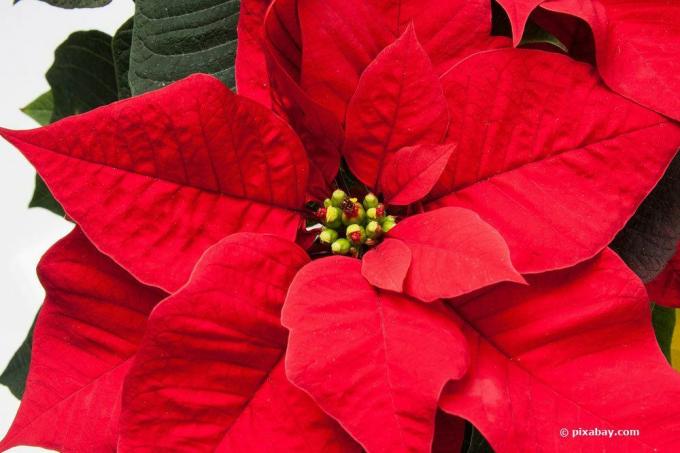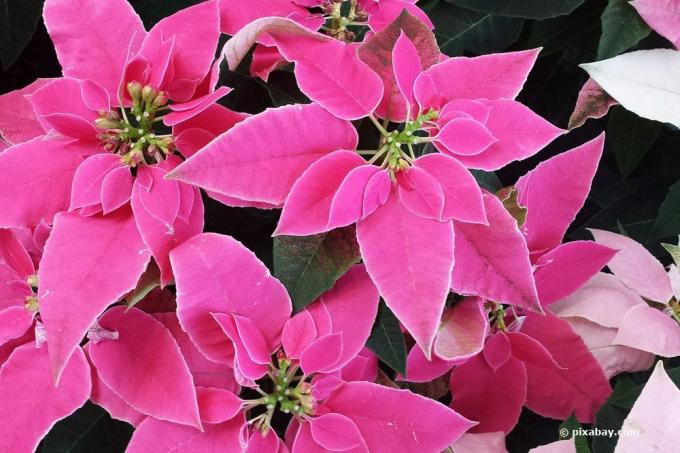
table of contents
- Importance of Correct Pouring
- Customize pouring
- Water the poinsettia properly
- time
- lot
- Quality of the irrigation water
- Create a drainage facility
- Misinterpretation of discarding leaves
- Repotting and watering
The sale of poinsettias is booming during Advent. It is particularly popular at this time. Unfortunately, it usually only has a short lifespan. In many cases, it doesn't even survive until the Christmas holidays. It is often faulty maintenance, in which watering plays a major role. How to properly water to extend the lifespan is described in the plant magazine.
Importance of Correct Pouring
Hardly any other houseplant reacts with such rapid death as this one Christmas starif not properly poured. As a rule, the most varied of plant species get used to the climatic conditions in their new home. The Euphorbia pulcherrima, however, shows itself extremely sensitive especially with regard to the water supply, if this does not correspond to the conditions in the region of origin. Many hobby gardeners and plant lovers do not know this and simply mean it too well and thus inflict life-threatening damage on the poinsettia, as the poinsettia is also called.
Customize pouring
original weather conditions
You can see the lifespan of a Euphorbia pulcherrima clearly and ideally over years extend if you take the typical weather conditions in the countries of origin of Central America during watering keep. While regular and even small or large amounts of water are common in Central Europe, the Euphorbia pulcherrima is only used to seldom, but short, heavy rain showers. This method of casting is quite unusual in German-speaking areas and is therefore usually not taken into account, which makes a short service life almost the rule.
Regularly giving too much water to poinsettias often only leads to a lifespan of a few weeks. It is therefore essential to adjust the watering process to the original weather conditions in the region of origin in order to achieve a significantly higher life expectancy.
Water the poinsettia properly
time
In order to imitate the rain conditions in the region of origin, you should only water the Christmas star when the substrate is still slightly damp, but has dried off well. It can cope just as badly with a completely dry soil as it does with permanent heavy moisture. Above all, waterlogging can quickly perish.
You can easily find out when the best time is given with the thumb test. This works as follows:
- Press the surface of the substrate with your thumb
- If the thumb can be pressed in by more than two centimeters, do not pour
- If the thumb can be depressed less than two centimeters, the best time to water has come
tip: During the heating season, it is better to check the moisture content of the substrate once more than too little. Dry heating air combined with the rapid absorption of water by the roots can suddenly dry out the soil much faster than expected. Once dried out, dying often takes its course.
lot
Poinsettias are very thirstywhen they get water and pull it up into their roots relatively quickly. They like it best when they are soaked with water so that they can store enough water. For this reason, you should always pour a poinsette generously.
Always pour in one operation. The irrigation water may and should even stand on the surface of the earth for a short time. But then under no circumstances should it be poured again if it has sunk. That would be too much irrigation water.
Quality of the irrigation water
The poinsettia is a Lime-sensitive plant. Especially when it comes into contact with calcareous irrigation water on the leaves and flowers, it quickly loses its brilliance and, in the worst case, its foliage.
Create a drainage facility
Drain hole in the pot
As much as the Euphorbia pulcherrima likes a lot of irrigation water at once, it is more sensitive to it Waterlogging. She does not tolerate this and should be prevented accordingly. You can do this by creating a drainage facility, among other things. This means that the poinsettia must be in a pot with a drainage hole.
Saucer
We recommend placing a saucer under the pot to collect excess water.
A saucer has the additional advantage that irrigation water that flows through can easily be sucked into the roots from below. This happens, for example, when the poinsettia is potted in poor quality soil or old substrate, which allows the irrigation water to seep through immediately due to the lack of water absorption. As a result, only a small proportion of water remains in the earth, which could possibly be too low for an optimal water supply.
It is important, however, that you do so at the latest ten minutes Dry the saucer to prevent waterlogging. During this time, the roots have ample opportunity to absorb water from the plate if necessary. The soil / substrate must then have the chance to dry off well before water is added again.
Misinterpretation of discarding leaves
In many cases, falling leaves on poinsettias are suspected to be a sign of insufficient water supply. For this reason, many plant lovers quickly reach for the watering can when looking at fallen leaves. It is usually poured vigorously in the hope of being able to compensate for the alleged water deficit. Especially with cheap offers from supermarkets or gas station goods with uncertain origin, it is not uncommon for leaves to fall off after a few days. In most cases this is due to too much irrigation water and often also to poor substrate quality.
Therefore you should use the soil / substrate with falling leaves Thumb testDetermine as described above and allow good drying. Only then should you water again. As a rule, the poinsettia recovers quite quickly.
Repotting and watering
Especially if leaves fall off shortly after purchase and the soil still feels damp, you should repot your newly acquired poinsettia in fresh, high-quality substrate. Then it is only poured lightly so that the substrate settles and the roots can anchor themselves better. Then you should only water again when the substrate has dried off well. (See thumb test under the heading “Time”).




